Nissan Maxima Service and Repair Manual: CVT fluid
Inspection
CHECKING CVT FLUID
The fluid level should be checked with the fluid warmed up to 50 to 80C (122 to 176F). The fluid level check procedure is as follows:
-
Check for fluid leakage.
-
With the engine warmed up, drive the vehicle in an urban area.
When ambient temperature is 20C (68F), it takes about 10 minutes for the CVT fluid to warm up to 50 to 80C (122 to 176F).
-
Park the vehicle on a level surface.
-
Apply parking brake firmly.
-
With engine at idle, while depressing brake pedal, move shift selector throughout the entire shift range.
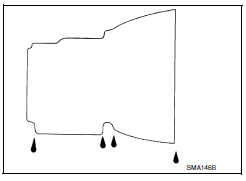
6. Pull out the CVT fluid level gauge from the CVT fluid charging pipe after pressing the tab on the CVT fluid level gauge to release the lock.

7. Wipe fluid off the CVT fluid level gauge. Insert the CVT fluid level gauge rotating 180 from the originally installed position, then securely push the CVT fluid level gauge until it meets the top end of the CVT fluid charging pipe
CAUTION: When wiping away the CVT fluid level gauge, always use lint-free paper, not a cloth rag.
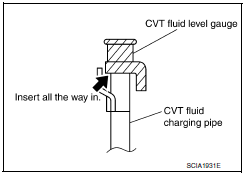
8. Place the shift selector in "P" or "N" position and check that the fluid level is within the specified range.
CAUTION: When reinstalling CVT fluid level gauge, insert it into the CVT fluid charging pipe and rotate it to the original installation position until securely locked.
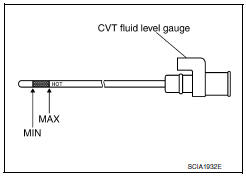
Check CVT fluid condition.
-
If CVT fluid is very dark or smells burned, check operation of CVT.
Flush cooling system after repair of CVT.
-
If CVT fluid contains frictional material (clutches, brakes, etc.), inspect and clean the CVT fluid cooler mounted in the radiator and flush cooler line using cleaning solvent and compressed air after repair of CVT. Refer to TM-157, "Cleaning".
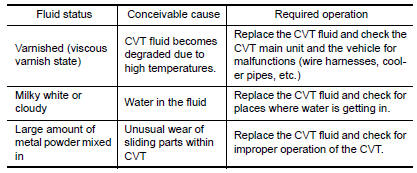
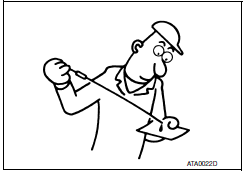
Changing
CAUTION: Replace a O-ring with new ones at the final stage of the operation when installing.
-
Remove drain plug from oil pan.
-
Remove O-ring from drain plug and discard the O-ring.
-
Install a new O-ring on drain plug.
CAUTION: Never reuse O-ring.
-
Install drain plug in oil pan. Refer to TM-177, "Exploded View".
-
Fill CVT fluid from CVT fluid charging pipe to the specified level.
CAUTION:
-
Use only Genuine NISSAN CVT Fluid NS-2. Never mix with other fluid
-
Using CVT fluid other than Genuine NISSAN CVT Fluid NS-2 will deteriorate in driveability and CVT durability, and may damage the CVT, which is not covered by the warranty.
-
When filling CVT fluid, take care not to scatter heat generating parts such as exhaust.
-
Sufficiently shake the container of CVT fluid before using.
-
Delete CVT fluid deterioration date with CONSULT after changing CVT fluid. Refer to TM-38, "CONSULT Function".
6. With the engine warmed up, drive the vehicle in an urban area.
NOTE: When ambient temperature is 20C (68F), it takes about 10 minutes for the CVT fluid to warm up to 50 to 80C (122 to 176F).
7. Check CVT fluid level and condition.
8. Repeat steps 1 to 5 if CVT fluid has been contaminated.
 CVT fluid cooler system
CVT fluid cooler system
Cleaning
Whenever an automatic transaxle is repaired, overhauled,
or replaced, the CVT fluid cooler mounted in the
radiator must be inspected and cleaned.
Metal debris and friction material, i ...
Other materials:
CAN communication circuit
Diagnosis Procedure
1.CONNECTOR INSPECTION
Turn the ignition switch OFF.
Disconnect the battery cable from the negative terminal.
Disconnect all the unit connectors on CAN communication system.
Check terminals and connectors for damage, bend and loose
connection.
2.CHECK HARNESS CON ...
Inside mirror
Wiring Diagram - Without Homelink Universal Transceiver
Wiring Diagram - With Homelink Universal Transceiver
...
Diagnosis and repair workflow
Work Flow
OVERALL SEQUENCE
DETAILED FLOW
1.CHECK SYMPTOM
Check the malfunction symptoms by performing the following items.
Interview the customer to obtain the malfunction information
(conditions and environment when the malfunction occurred).
Check the symptom.
2.SELF-DIAGNOSIS (C ...
Nissan Maxima Owners Manual
- Illustrated table of contents
- Safety-Seats, seat belts and supplemental restraint system
- Instruments and controls
- Pre-driving checks and adjustments
- Monitor, climate, audio, phone and voice recognition systems
- Starting and driving
- In case of emergency
- Appearance and care
- Do-it-yourself
- Maintenance and schedules
- Technical and consumer information
Nissan Maxima Service and Repair Manual
0.0056

